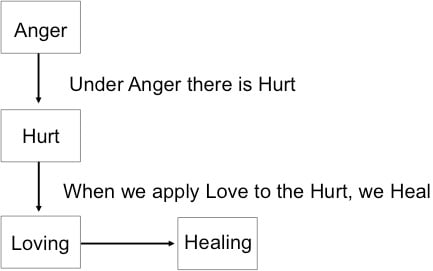
Did you know that stuffing down your anger impacts your mental health?
Serious conditions associated with stuffed-down anger include depression, anxiety, addiction, insomnia, and others, according to the nation’s top mental health experts.
As the researchers and authors of The Effects of Anger on the Brain and Body (published in the National Forum Journal of Counseling and Addiction) wrote:
"Holding back anger can lead to mental illnesses including depression. An emotion such as anger will not go away if ignored. It will only get stronger and can cause severe problems."
According to John Schinnerer, an anger management coach and expert, other ways that chronic anger can affects a person’s well-being include: "anxiety, addiction, depression, fatigue, decreased immunity, insomnia, brain fog, low self-esteem, and a higher probability of abuse."
Clearly, unaddressed anger has the potential to devastate your life. It’s imperative that you address it effectively. So, how do you do that?
Read on to learn …
- Why anger arises from underlying hurt
- How to heal hurt
- Strategies to burn off “hot” anger
- The relationship between anger and depression
- How to forgive your judgments and limiting beliefs
Understanding Anger
The first thing you need to know is that beneath every feeling of anger, there is a hurt that is present. As Dr. Martha Beck noted, anger arises within us “when something that we need is absent, or something that we cannot tolerate is present."
When we don't have what we need, or we're in the presence of something we can't tolerate, then a part of us is hurting, by definition. We don't have what we need. There's a gap there, and it hurts. If we're in the presence of something we cannot tolerate, then we're hurt, as well.
Beneath every feeling of anger, there is an underlying hurt that is present.
How to Heal the Hurt from Anger
You may be thinking, “Okay, well, I understand that in order to heal my anger, I need to heal the underlying hurt, right? How do I do that? How do I heal the hurt?”
Well, the answer is very simple. It's not always easy, but it's pretty straightforward.
When we apply love to the parts of ourselves that hurt, then we heal. When we apply love to the hurts that underlie the anger, that's when we're able to heal and move on from the anger.
Then, of course, the question is, "How? How do we do that?"
Most of us did not learn this in our family systems or in schools, unless we were very fortunate, and we had some teachers or parents or authority figures who were very aware and very in tune. By and large, our culture does not teach this. There are not a lot of opportunity for us to really learn how to heal that underlying hurt.
The good news is that you can always start where you are. Now is the perfect time to start. Here are some ways that you can apply love to the parts of yourselves that hurt, and thereby heal your anger.
Strategies and Tools for Anger Management
First, here’s a strategy to burn off some of your hot anger.
Use this when you're really upset and you just want to explode. Instead of yelling at someone else, do this to manage your anger. The tool is called Free Form Writing.
To start, go off by yourself. Find someplace that you won't be disturbed. For those of you who are parents, locking yourself in your car is a really good way to do this. If you say, "I can't find time to do these exercises, and I don't have the privacy,” then the next time you drop your kids off at school or at a sporting event, go park the car somewhere, and lock the doors. Voila, you've got your private time.  Once you're alone, set the timer on your phone or on your watch for a minimum of 10 minutes, ideally around 15, but 10 is the bare minimum for this exercise.
Once you're alone, set the timer on your phone or on your watch for a minimum of 10 minutes, ideally around 15, but 10 is the bare minimum for this exercise.
All you need is a pen and a few pieces of paper, nothing fancy. You set your timer for 10 minutes, and then just put pen to paper and write.
Let yourself be as raw and uncensored and as politically incorrect as you want to be. No one is going to see what you write. No one is going to reread this - not even you! - so for 10 minutes you just let your anger flow. You get it out of your body, and you get it onto that paper, and you just write and write and write all the things that you're pissed off about. “I hate this, and I hate that, and I can't stand it, and it's awful.” Say whatever you want, curse, swear, anything.
Again, nobody's going to see it.
When that timer goes off, you stop. Then take that piece of paper and destroy it. You can shred it, or ideally, burn it; burning is very cathartic. Of course, be safe. Dispose of the paper in the safest and most complete way you can. If you are not able to burn it, you can rip it up and put the pieces in water, so that the ink runs, and so it's destroyed. Then you throw the soggy mess in the garbage.
It’s important to do a really complete destruction of whatever you wrote, because you just want to release that anger. It's all about releasing the emotion. That's one way to let the steam out.
Anger and Depression
Depression is anger turned inward. When we turn our anger inward, and we don't allow ourselves to express it or even to feel it fully, then it becomes depression.
Depression may seem like sadness, hopelessness, and that's very much a part of it, but it begins with the experience of turning our anger inward and refusing to feel it. If you've dealt with depression, it’s particularly important to have a time where you are letting your anger flow, so that you're not just stuffing it.
Free Form Writing is a way to let yourself be honest about what you're feeling and tap into the anger that underlies depression.
Once you've burned off hot anger, and you're willing to work with those unresolved issues that were contributing to your anger, then what do you do?
The Nature of Anger and Unresolved Issues
First, most anger points to unresolved issues. If you're angry and you're stressed, then you typically have an unresolved issue. There's no judgment here. This is not bad. All of us have unresolved issues. It is a part of being human, so there's no need to judge yourself.
Instead, you can just say, “Oh look, I'm really pissed. I'm feeling really angry right now. This is my latest opportunity for growth. This is something else being revealed to me that needs to be healed.”
When you do that, then you can take that next step forward in your own growth and development.
By contrast, if you refuse to deal with your upset and you stuff it or pretend it's not there, then you can't evolve and grow past that sticking point. Life is going to keep throwing things at you that's going to bring back that original, unresolved issue.
It's similar to a prerequisite class in college; you have to take Psychology 101 before you can move on to Psychology 102. You can't bypass an unresolved issue and just think, “Oh, I'd rather not do that one. I want to do another one.”
It's going to come back. It will be a prerequisite on behalf of your growth, so you might as well deal with it now.
Anger and Addiction Recovery
Unresolved anger leads to unresolved core issues. In our experience running a successful Non 12-Step rehab, virtually all the folks we see with addiction problems have been struggling with underlying core issues.
One of the powerful techniques we use to work with anger is based in Rational Emotive Therapy (RET).
The idea behind RET is that we all experience reality subjectively.
None of us have a purely objective view of the world, because we filter everything through the lens of our perceptions, thoughts, experiences, and memories, so there is no template for this is exactly what happened. 10 different people witness an event, and they have 10 different experiences of that event.
 That's important because when we start to work with our anger, we need to look at our subjective perceptions of events in our lives. We need to look at our judgments, our limiting beliefs and our projections ... all the concepts that we build around the events of reality.
That's important because when we start to work with our anger, we need to look at our subjective perceptions of events in our lives. We need to look at our judgments, our limiting beliefs and our projections ... all the concepts that we build around the events of reality.
Humans love to tell stories, and we are gifted with imagination, and we love to make things mean something.
For example, suppose your spouse walks into the room and doesn't speak to you, and you assume that they're judging you.
However, maybe their experience is that they're just distracted. Maybe they didn't even notice that you were looking at them.
Even if someone says, “I hate you,” it can cause you a different degree of upset depending on what you make it mean.
If you're making that mean, “I'm a despicable human being, and I don't deserve to live,” then that's pretty upsetting.
If you're making that same statement mean, “That person is really in pain, and they're lashing out at me because they're hurting”, then your level of upset is different.
Rational Emotive Therapy helps us to identify our judgments and our limiting beliefs, because these are the things that are causing us the anger, not the external event.
It's our internal reality that is causing the internal anger.
Judgments, Anger and Addiction
In order to do this inner work, we begin, as we always begin, by centering ourselves and our loving hearts.
Pick an image or a relationship or a memory that really brings you to a place of unconditional love. Some people imagine their partners or their pets or a dear friend, something that allows you to tap into that energy of acceptance and love within yourself.
Then, when you're in that place, you ask yourself, “What was it that triggered my feeling of upset? What happened in the real world? Then, what did I think about that?”
For example: “My spouse walked through the room, and I looked up at them, but they didn't look back at me.”
You would write down what happened: My spouse walked across the room. I looked up, and he/she didn't meet my gaze. That's the factual statement of what happened.
Then you ask yourself, “What are my judgments about this event?” A judgment is anything that sounds like should, would, could. For example …
- "He should have looked at me."
- "I should have tried harder to get his attention."
- "He shouldn’t be so cold."
- "I'm not worth looking at."
Judgments can be against the other, against the situation or against reality, or against yourself.
Once you have those judgments written down, look at your limiting beliefs.
Liming Beliefs Definition
Limiting beliefs are more global rules about the way the world works and any thoughts or ideas that constrain us in some way.
They often feel really heavy, and they bring us down. Limiting beliefs are generalizations that we've created about the way the world works. Often, it's hard to identify them or see past them, because they tend to operate in our subconscious minds.
Examples of limiting beliefs include but are not limited to:
- I can’t tell the truth because I may get judged
- I don’t want to get close to this person because I may be heartbroken
- I don’t want to ask for what I want because I might get rejected
- I can’t trust people because I’ve been burned before
- I can’t pursue my dreams because I might fail
- I can’t do X because of Y
Your limiting belief might be, for example, “My spouse should always know what I need. He should know. He should just know that I needed contact in that moment.”
Then, walk yourself through a process of forgiveness for those judgments and for those limiting beliefs.
Here's a helpful template for dealing with limiting beliefs:
“I forgive myself for judging myself as … (fill in the blank), and the truth is ... (fill in the blank). In the first blank we fill in our judgment. In that second blank you fill in what the voice of unconditional love would say.
In this case, it might be, “I forgive myself for judging myself as unworthy, and the truth is that I am loved, and that I am cherished, and that I am worthy.” If that doesn't ring true for you, that's fine. Another example might be, “ … the truth is that I accept myself.” You judged yourself as unworthy, but now you accept yourself. You've made a shift.

Overcoming Limiting Beliefs
Similarly, the framework for forgiving a limiting belief sounds like this. “I forgive myself for accepting the limiting belief that …” Fill in the blank.
For example, "I forgive myself for accepting the limited believe that my spouse should always know what I need; and the truth going forward for me is..."
Then you fill in the blank, again tapping into unconditional love.
For example, you might finish with, “I can take care of my own needs,” or, “My needs will always be met, somehow, some way. I will always be provided for.”
At the end, of course, always remember to praise yourself for a job well done.
Offering yourself forgiveness and forgiving these judgments and limiting beliefs is intense work on both the mental and the emotional levels. So, remember to congratulate yourself for doing it at all, because it is brave. It contributes to not only your well being, but to the well being of the world, because when we heal our own anger and our own hurt, that affects everyone around us. Healing ripples outward.
Would you like to learn more about anger, mental illness, limiting beliefs and how it can contribute to addiction? Download our free eBook, "Healing Underlying Core Issues."
Download EBook Healing Core Issues



